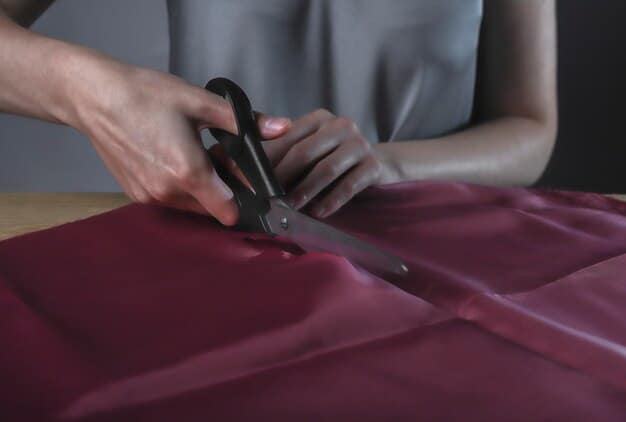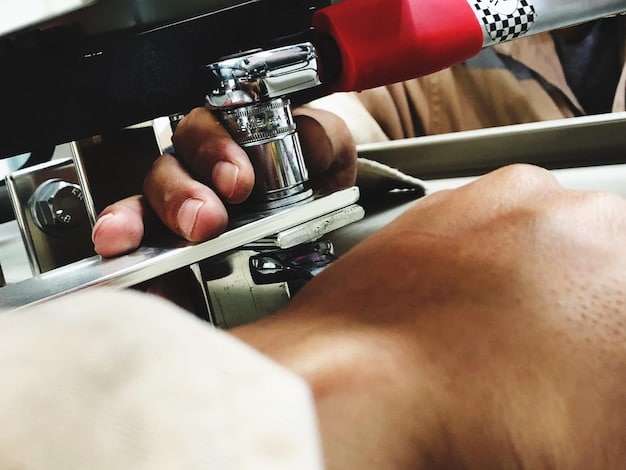Clothing Alterations 101: Perfect Fit in the US

Advertisements
Clothing Alterations 101 guides you through tailoring clothes for a perfect fit in the US, covering everything from essential tools and basic techniques to finding professional tailors and understanding costs, ensuring your wardrobe always looks its best.
Do you struggle to find clothes that fit perfectly off the rack? Clothing Alterations 101: How to Tailor Your Clothes for a Perfect Fit in the US provides a comprehensive guide to achieving that custom-tailored look without breaking the bank.
Advertisements
Understanding the Basics of Clothing Alterations
Clothing alterations are more than just hemming pants or taking in a waistline. They’re about transforming ready-to-wear garments into pieces that complement your unique body shape. Let’s delve into the fundamentals of why alterations matter and what they entail.
Why Alterations Matter
In a world of mass-produced clothing, achieving a perfect fit can seem like a distant dream. Alterations bridge this gap, allowing you to customize your clothes for optimal comfort and style. They can also save you money by extending the lifespan of your favorite pieces.
Advertisements
Common Types of Alterations
From simple fixes to more complex restyling, alterations cover a wide range of adjustments. Understanding these options empowers you to make informed decisions about your wardrobe.
- Hemming pants, skirts, and dresses to the ideal length.
- Taking in or letting out waistlines and side seams for a contoured fit.
- Adjusting sleeve lengths to suit your arm length.
- Replacing zippers or buttons for renewed functionality.

Ultimately, clothing alterations are about creating a wardrobe that reflects your personal style and fits you impeccably. By understanding the basics, you can unlock the potential of your clothes and feel confident in every outfit.
Essential Tools for DIY Clothing Alterations
Embarking on DIY clothing alterations requires having the right tools at your disposal. While professional tailors have specialized equipment, you can achieve impressive results with a few essential items. Let’s explore what you’ll need to get started.
Must-Have Sewing Supplies
A well-stocked sewing kit is the foundation of any successful alteration project. These tools will help you measure, mark, cut, and stitch with precision.
- Measuring tape: For accurate body and garment measurements.
- Seam ripper: To carefully remove unwanted stitches.
- Fabric scissors: Sharp scissors dedicated solely to cutting fabric.
- Pins: To hold fabric pieces together before sewing.
Choosing the Right Sewing Machine
While hand-sewing is suitable for small repairs, a sewing machine significantly speeds up the alteration process. Consider these factors when selecting a machine.
A sewing machine is an important investment, but if you are only intending on doing light alterations you may not require a brand new, fancy one. There are many older models that still function.
- Stitch options: Look for straight stitch, zigzag stitch, and buttonhole settings.
- Adjustable speed: Control the machine’s speed for greater accuracy.
- Needle variety: Ensure compatibility with different fabric types.
Having the right tools makes all the difference in DIY clothing alterations. Investing in quality supplies will not only improve your results but also make the process more enjoyable.
Basic Techniques for Altering Clothes at Home
Once you have the essential tools, it’s time to learn some basic alteration techniques. These skills will empower you to tackle a variety of common fitting issues and customize your clothes with confidence.
Hemming Pants and Skirts
Hemming is one of the most common alterations. Mastering this technique allows you to adjust the length of pants, skirts, and dresses to your preferred inseam or hemline.
Taking In or Letting Out Seams
Adjusting the side seams or waistline of a garment can dramatically improve its fit. This technique is particularly useful for clothes that are too loose or too tight.
Taking in a seam can greatly improve a garment that is just a little too big. Letting out a seam can be tricky if there is not enough fabric left available to work with.

- Turn the garment inside out and put it on.
- Pinch the fabric along the side seams to achieve the desired fit.
- Pin along the new seam line and remove the garment.
- Sew along the pinned line and trim any excess fabric.
With practice, you’ll gain confidence in your ability to alter clothes at home. Start with simple projects and gradually progress to more complex alterations.
Finding a Professional Tailor in the US
While DIY alterations are rewarding, some projects require the expertise of a professional tailor. Whether it’s a complex garment reconstruction or a delicate fabric, knowing how to find a skilled tailor is essential.
Where to Look for Tailors
Finding a reputable tailor involves exploring various resources and considering your specific needs. Start by checking these locations.
- Local dry cleaners often offer tailoring services as well.
- Yelp and Google Reviews provide valuable insights into a tailor’s reputation.
- Specialty boutiques may have in-house tailors or recommend trusted professionals.
Questions to Ask a Potential Tailor
Before entrusting your clothes to a tailor, it’s important to ask the right questions to gauge their experience and expertise.
- How long have you been working as a tailor?
- Can I see examples of your previous work?
- What is your experience working with [specific fabric type]?
Ultimately, finding the right tailor is about building a relationship based on trust and communication. Take the time to research your options and choose a professional who aligns with your needs.
Understanding Clothing Alteration Costs in the US
One of the biggest advantages of altering clothes is the financial savings compared to buying new garments. However, it’s important to understand the factors that influence alteration costs and how to budget accordingly.
Factors Affecting Alteration Prices
Alteration prices in the US vary depending on several factors, including the complexity of the alteration, the type of fabric, and the tailor’s location and expertise. Keep these in mind when budgeting.
Typical Price Ranges for Common Alterations
While prices vary, knowing the typical price ranges for common alterations can help you estimate the cost of your project.
- Hemming pants: $10-$25
- Taking in a waistline: $15-$40
- Replacing a zipper: $20-$50
Always ask for a written estimate before proceeding with any alteration project. This will help you avoid surprises and ensure that you’re comfortable with the cost.
Tips for a Successful Clothing Alteration Experience
To ensure a successful clothing alteration experience, it’s essential to communicate effectively with your tailor and prepare your garments appropriately. Follow these tips to achieve the best possible results.
Communicating Your Needs Clearly
Effective communication is the key to a satisfying alteration experience. Be specific about your desired fit and style, and provide clear instructions to your tailor.
- Be clear about the fit that you are trying to achieve.
- Provide pictures for clarity if you have them.
- Communicate any specifics that are important to you.
Preparing Your Garments for Alteration
Proper preparation can streamline the alteration process and help your tailor achieve optimal results. Take these steps before your appointment.
- Wash or dry clean your garments before bringing them in for alteration.
- Wear the shoes and undergarments you plan to wear with the altered garment.
- Bring any reference photos or sketches to illustrate your desired look.
By following these tips, you can ensure a smooth and successful clothing alteration experience, resulting in clothes that fit you perfectly and make you feel confident.
| Key Point | Brief Description |
|---|---|
| 🧵 Essential Tools | Tools like measuring tapes and seam rippers are crucial for alterations. |
| 📏 Measuring Accurately | Accurate measurements ensure the clothes fit perfectly after alterations. |
| 🪡 Basic Techniques | Learn basic techniques like hemming and taking in seams. |
| 💰 Alteration Costs | Understanding costs helps in budgeting for professional alterations. |
Frequently Asked Questions
▼
The most common alterations include hemming pants, skirts, and dresses; taking in or letting out seams; adjusting sleeve lengths; and replacing zippers or buttons.
▼
You can find a good tailor by checking local dry cleaners, asking for recommendations from specialty boutiques, or reading online reviews on sites like Yelp and Google Reviews.
▼
Ask about their experience, especially with similar fabrics or alterations, and if you can see examples of their work. Also it is important to have a discussion about the level of fit you desire.
▼
The cost varies, but typically hemming pants ranges from $10-$25, taking in a waistline from $15-$40, and replacing a zipper from $20-$50, depending on the complexity and location.
▼
Wash or dry clean your garments, wear the shoes and undergarments to be worn with the outfit, and bring reference photos to clearly communicate your desired fit and style.
Conclusion
Mastering clothing alterations, whether through DIY efforts or by hiring a professional tailor, is a valuable skill that ensures your wardrobe fits you perfectly, enhances your style, and saves money. These skills empower you to customize your clothing for optimal comfort and confidence in the US and beyond.